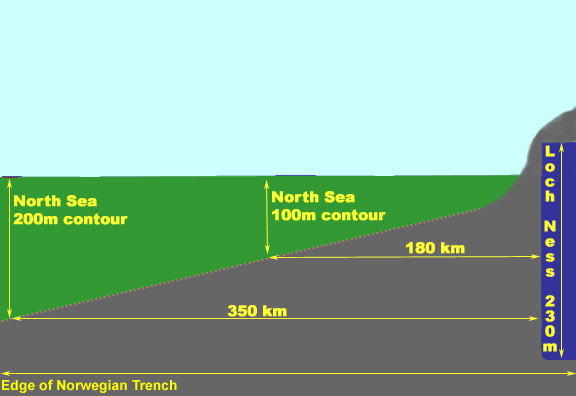Elsewhere on this web site I offer suggestions as to why the existence
of tunnels is unnecessary, so on this page I will offer a few thoughts
as to why they are also unlikely to exist.
Tunnels and caves are most often found in areas of soluble rock such as limestone. Limestone is formed from the accumulated remains of all manner of deceased sea creatures. Over extremely long periods of time slightly acidic groundwater dissolves the carbonate component of the rock and the remaining particles are washed away. Unfortunately, the rocks between Loch Ness and the sea are not of this kind.
In order to be of any practical value to a hypothetical animal reputed to be at least 10 m long and 2 m diameter, any "simple" tunnel would need to be consistently of a greater diameter, and there would logically be a tremendous flow of water through this tunnel due to the 15 m difference in levels between the Loch Ness and the sea. As the tunnel would have existed for at least 10,000 years its sides would probably be worn smooth, and I could foresee a water velocity of between 15 - 30 kph, 7-15 m/s,10 -20 mph - perhaps much more. Any creature swimming against this torrent from the sea to the loch would need to swim at a greater speed than this for at least 12 km in total darkness without needing to breathe air. Such a tunnel would therefore be unsuitable for use by mammals, reptiles and amphibians, leaving only fish and invertebrates as potential customers. If the hypothetical Nessie is not a fish or invertebrate, then a tunnel like this is of no use; if it is either, then it could use the River Ness like the other migratory creatures.
From my experience crawling and diving in caves and rivers I would be amazed if such a passage could survive for 10,000 years without getting blocked by logs and other debris. Any outlet in the sea would create an upwelling of (less dense) fresh-water which would have been noticed and used by mariners or fishermen centuries ago. And yes, the water level in the loch would tend to fall to sea level and the River Ness would dry up in times of drought - neither of which event has been observed by us sharp eyed locals. The greater the length of any suggested tunnel, the less likely it is to exist, and so the most likely location for any tunnel mouth would be in the Inverness and Beauly firths, at the shortest distance from Loch Ness. These firths are, however, generally very shallow, typically 5-10 m deep, and an upwelling of fresh water would be very obvious to everyone in the area.
A more elaborate tunnel involving a u-bend has been suggested, in which the tunnel which has its entrance beneath the surface of Loch Ness then rises inside a hill at the lochside to a level higher than the loch's surface before continuing as a dry tunnel for the 12 km (minimum) towards the coast, where it enters a "sump" with an outlet into the sea. No mechanism for the formation of a tunnel like this has ever been published before, but LNI expedition members in the 1960's discussed this and many other issues, and the only functional kind of tunnel we could imagine would be some bizarre glacial equivalent of a "lava-tube" dating from a time when the loch level was much higher than it is today - (and I'm not aware that it ever was).
This underground tube was at first water-filled, then froze into ice. The line of the tunnel would need to originate below present loch level, rises ABOVE present water level, then descend through the glacial deposits to emerge once again below the surface of the sea. Because part of it is above the loch surface level, no water flows through it.
Imagine (if you must) the principle of the British lavatory pan, as designed by Thomas Crapper.
The water was frozen for a few tens of thousands of years, allowing the ground to compact around it, and then the water melted to leave a partly dry tunnel. All the other objections remain to its existence, it is still more than 12 km long, perfectly dark, formed in a most unlikely set of geological circumstances and generally improbable to the point of daftness. It also has the added disbenefit of requiring our Nessies to walk at least 10km.
All of these ideas also presume the extremely unlikely scenario of an unclassified species of mammal, reptile or amphibian, of whale-like dimensions, which only "gets seen" in Loch Ness and similar lakes, but breathes air, is never washed ashore, nor captured either alive or dead in the nets of the worlds fishing fishing fleet. Read more about them here.

Diagram showing approximate scale depth of Loch Ness
and adjacent sea
Copyright (C) Dick Raynor 2002
(This page is based on a series of my postings in the Nessie discussion group in 2001, starting here.)